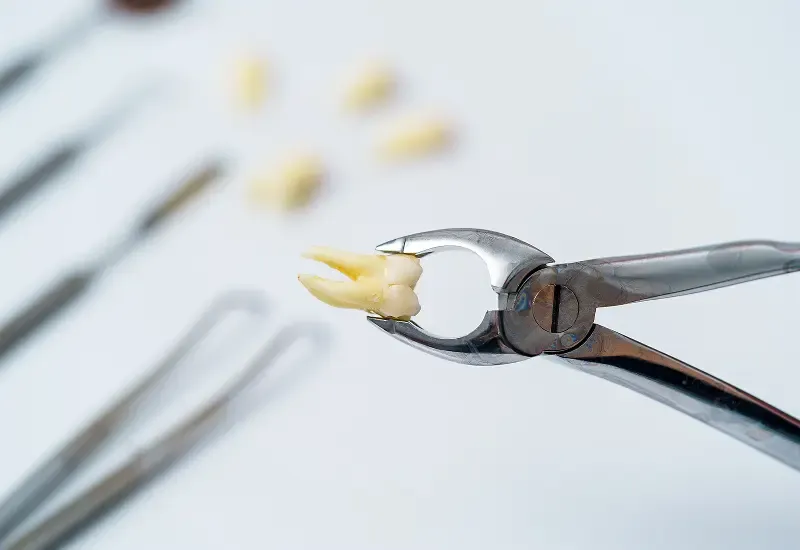
The Indications for Third-Molar Extractions

Dr. Uvika Singh
03 April 2025
Third molars, commonly known as wisdom teeth, are the last set of molars that typically emerge in young adulthood, usually between the ages of 17 and 25. While some people have enough space in their mouths to accommodate these teeth without any issues, many individuals experience problems that necessitate their removal.
In this blog we will explore the reasons why wisdom teeth may need to be extracted, the potential complications, and more.
Common Age for Extraction
Most individuals will start to see their wisdom teeth emerge in their late teens or early twenties. Even though the exact timing can vary. Some people may find that their wisdom teeth come in without any issues.
On the other hand, others may experience complications that prompt a dentist to recommend extraction. Regular dental check-ups are essential during this time to monitor the development of these teeth.

Indications for Third-Molar Extraction
Several factors can indicate that a person should have their wisdom teeth extracted. Here are some of the most common reasons:
Impaction
One of the most common reasons for wisdom tooth removal is impaction. This occurs when there is not enough space in the mouth. This will be causing the tooth to become trapped beneath the gum line. Impacted wisdom teeth can lead to pain, swelling, and infection.
Crowding
Even if wisdom teeth come in normally, they can sometimes push against neighboring teeth. It will be causing crowding and misalignment. This can be particularly concerning for individuals who have had braces or orthodontic work.
Crowded teeth can complicate oral hygiene which makes it harder to clean effectively. This misalignment can lead to uneven wear on teeth, increased risk of cavities, and gum disease.
Cavities and Gum Disease
Wisdom teeth are located at the back of your mouth. This makes it hard to clean properly. Due to this, they are more likely to get cavities and gum disease.
If a wisdom tooth gets a cavity that can’t be fixed, it may need to be removed. Gum disease around these teeth can also cause more problems if not treated. This is because the bacteria can spread to other parts of the mouth, worsening any existing dental issues.
Pain and Discomfort
If wisdom teeth begin to grow in and cause pain, discomfort, or swelling. It may be an indication that they need to be removed. Some individuals experience jaw pain or headaches related to their wisdom teeth.
Infection
When wisdom teeth are only partially out, they can create pockets in the gums where bacteria can grow, leading to infections. Symptoms of an infection may include pain, swelling, bad breath, and even fever.
In these cases, removing the tooth can help solve the problem.
The infection can also cause a condition called pericoronitis. This is inflammation of the gum tissue around the partially erupted tooth. This can be very uncomfortable and make it hard to keep your mouth clean.
Cysts and Tumor
In rare cases, wisdom teeth can lead to cysts or tumors in the jaw. These growths can harm nearby teeth and bone, making it necessary to remove the affected tooth.
Cysts can create larger spaces in the jawbone and may require further surgery. If not treated, these cysts can result in serious problems, including bone loss.
Preventive Measures
Some dentists suggest removing wisdom teeth before they cause problems, especially if X-rays show that the teeth are impacted or likely to cause issues later. Taking out wisdom teeth early can help patients avoid more complicated procedures and discomfort in the future.
This is particularly common for younger patients. This is because their tooth roots are not fully developed. This makes removal easier and recovery faster.
“Hair is the first thing. And teeth the second. Hair and teeth. A man got those two things, he’s got it all.’
– James Brown”
What to Expect During the Extraction
If your dentist determines that your wisdom teeth need to be removed, here is what you can expect during the procedure:
Consultation
Before the extraction, you will have a consultation with your dentist or oral surgeon. They will discuss your medical history, take X-rays, and explain the procedure in detail.
Anesthesia
Depending on the complexity of the extraction and your comfort level, the dentist will administer local anesthesia, sedation, or general anesthesia. This helps ensure that you remain pain-free during the procedure.
Procedure
The dentist will remove the wisdom teeth through a surgical procedure. It may involve cutting through the gum tissue and possibly removing some bone. If the teeth are impacted, they may be broken into smaller pieces for easier removal.
Duration
The extraction usually takes around 30 minutes to an hour. The exact time will depend on the number of teeth being removed and their condition.
When to Call Your Dentist?
While recovery is typically straightforward, there are some signs that you should contact your dentist:
Excessive Bleeding
If bleeding does not subside after a few hours or becomes severe, reach out to your dentist. Minor bleeding is normal, but significant bleeding requires attention.
Severe Pain
Some discomfort is normal. However, if you experience severe pain that worsens over time, it may indicate an issue that requires attention. Dry sockets or infection can cause increased pain. If you suspect you have dry socket, then your dentist can provide treatment to alleviate the discomfort.

Need Any Help?
Contact UsSigns of Infection
Symptoms such as fever, swelling that does not improve, or pus coming from the extraction site should prompt a call to your dentist. Infections require prompt treatment to prevent complications. Early intervention can often prevent the infection from spreading.
Difficulty Opening Your Mouth
If you experience significant difficulty opening your mouth or swallowing, this could indicate a complication that needs medical attention. Your dentist can evaluate your condition and determine if further treatment is necessary.
Recovery After Extraction
After your tooth extraction, it is normal to experience some swelling, pain, and discomfort. Your dentist will give you specific instructions on managing pain, what to eat, and when to resume activities. Make sure to follow these guidelines for a smooth recovery. You might need a friend or family member to drive you home, especially if you have sedation.
Apply ice packs to your cheeks for the first 24 hours to reduce swelling. Use them for 15 minutes, then take a 15-minute break. Some swelling is normal. However, if it gets too much or changes color, contact your dentist.
Take over-the-counter pain relievers or any prescribed medications as your dentist advises. If your pain continues or gets worse, let your dentist know. Keep an eye out for signs of complications, like increased swelling or ongoing pain.
For the first few days, stick to soft foods like yogurt, applesauce, and smoothies. Avoid hard, crunchy, or spicy foods that might irritate the area. Slowly reintroduce solid foods as you feel comfortable, but don’t chew directly on the extraction site.
Drink plenty of fluids but avoid straws because the suction can lead to a painful condition called dry socket. Drink from a cup or bottle instead to stay hydrated and support healing.
Keep your mouth clean but be gentle around the extraction site. Your dentist may recommend rinsing with warm salt water to help with healing. Avoid brushing directly over the area for the first few days and return to your regular oral care routine as soon as you can, being cautious around the surgical site.
Final Thoughts
Not everyone needs to have their wisdom teeth taken out. However, there are some signs that removal might be necessary. Issues like impaction, crowding, pain, and infection can all indicate that it is time for extraction. Knowing these reasons can help you make better choices about your dental health.
Contact your dentist today in Oakland, Dr. Uvika Singh, at Advance Dental Concepts Oakland, to learn more about dental crowns and dental bridges.
Resource:
Share This:
Disclaimer
*This media/content or any other on this website does not prescribe, recommend, or prevent any treatment or procedure. Therefore, we highly recommend that you get the advice of a qualified dentist or other medical practitioners regarding your specific dental condition. *
